The Chapter House on Johnson Park:
Home to the Women Teachers' Association for 52 Happy Years
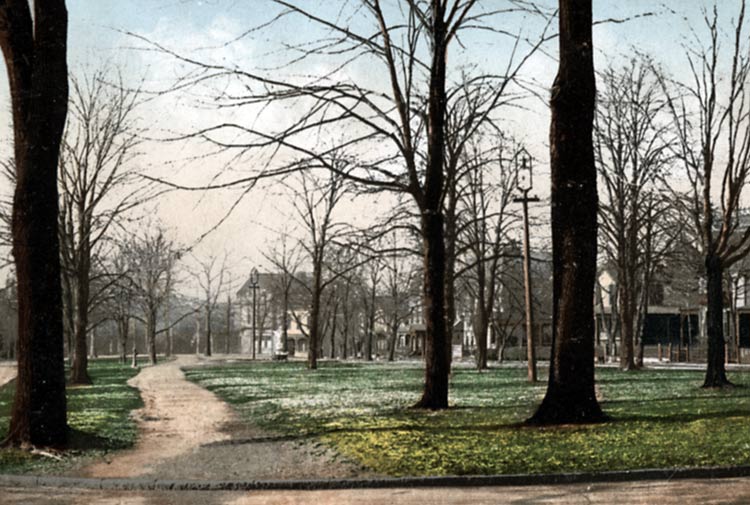
Johnson Park, c 1900, showing the Chapter House (center) built by the Buffalo Seminary (aka Female Academy) Graduates Association.
Image source: private collection
The clubhouse at 95 Johnson Park was designed by Rochester architect James G. Cutler, well known to Buffalonians in 1884 when the building was completed. The Graduates Assocation of the Buffalo Seminary built their three-story, brick clubhouse to provide a place for intellectual and artistic enlightenment. The president at the time, Mrs. Noyes, named it the Chapter House, using the term applied to fraternity houses. When the organization decided to expand its membership and move to Delaware Avenue ten years later, the building was for sale.
The Women Teachers Association was founded in 1889 by competent teachers concerned about the absymal quality of Buffalo's schools. The flood of immigrants had created classes of 60-80 children with insufficient seats, poor air circulation and lighting, poor quality textbooks of such paucity that the same book had to be read over and over for the entire year. The qualifications of employed teachers were uneven, there was no professional staff development, and teachers had not received a raise in salary for nearly 30 years. The present elected superintendent, James F. Crooker, was not receptive to initiatives from the 682 teachers, whose employment he alone controlled, in addition to controlling the curriculum of the 51 schools in the city.
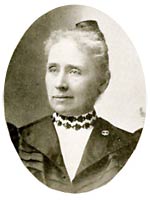 The first meeting to propose the association was announced in several days' editions of the Buffalo Express, calling women teachers to the Women's Union building on Niagara Square to gather to form a club whose purpose would be the "advancement of the quality of work done in our schools." The first meeting, May 25, had 125 teachers attending. The second, on June 3, had only 59. A constitution and by-laws were drawn up and, when school began in the fall, just 36 teachers dared to attend the first meeting of the Women Teachers Association. They feared repercussions from the superintendent. By 1890, membership under president Adelaide Graybiel (photo at left), Principal at School 46, increased to 89 but it fell again the next year. Members, unaccustomed to leadership roles, were reluctant to run for WTA offices.
The first meeting to propose the association was announced in several days' editions of the Buffalo Express, calling women teachers to the Women's Union building on Niagara Square to gather to form a club whose purpose would be the "advancement of the quality of work done in our schools." The first meeting, May 25, had 125 teachers attending. The second, on June 3, had only 59. A constitution and by-laws were drawn up and, when school began in the fall, just 36 teachers dared to attend the first meeting of the Women Teachers Association. They feared repercussions from the superintendent. By 1890, membership under president Adelaide Graybiel (photo at left), Principal at School 46, increased to 89 but it fell again the next year. Members, unaccustomed to leadership roles, were reluctant to run for WTA offices.
But everything began to change for the Buffalo schools and the WTA beginning in 1891, when Ida C. Bender, M.D. was elected president of the WTA. She would lead that organization with energy and charisma for the next 22 years. In 1892, the Association voted to apply for memebership in the General Federation of Women's Clubs. And, in 1893, her close friend, Henry Emerson, was elected Superintendent of schools. He named her Supervisor of Primary Grades and became an open supporter, and frequent visitor, of the WTA. Membership grew rapidly.
 The WTA incorporated in 1893 and began to experience growing pains. It met in the Women's Union, the Central Library, Central High School. It finally rented Schuler Hall at 960 Main Street for $5 per month and remained there until the ideal opportunity arose when the Chapter House was offered for sale. The building and its lot had cost the Graduate Students $17,500 in 1884. They offered it to the WTA in 1895 for $12,500. The WTA had around $400 in its treasury and succeeded in raising the first payment, $6,500 within a few months. The Women Teachers Association would be the first teachers' organization in the U.S. to have a permanent home.
The WTA incorporated in 1893 and began to experience growing pains. It met in the Women's Union, the Central Library, Central High School. It finally rented Schuler Hall at 960 Main Street for $5 per month and remained there until the ideal opportunity arose when the Chapter House was offered for sale. The building and its lot had cost the Graduate Students $17,500 in 1884. They offered it to the WTA in 1895 for $12,500. The WTA had around $400 in its treasury and succeeded in raising the first payment, $6,500 within a few months. The Women Teachers Association would be the first teachers' organization in the U.S. to have a permanent home.
By 1889, the WTA had made some improvements to the Chapter House. It was being extensively utilized as headquarters for attendees during state and national educational conferences. The WTA was active in the Pan-American Exposition in 1901, contributing to Buffalo school exhibits for the Manufactures and Liberal Arts building, hosting 500 visiting Toronto teachers, and offering a Cuban group use of the Chapter House. After the Exposition, the WTA received 60 "black, antique chairs," a couch, Flemish oak buffet, and one of the "dainty round tables" from the Women's Building at the Exposition.
 WTA President Dr. Ida C. Bender quickly imprinted her style on the organization when she became president in 1891. She had occupied may roles in her 13-year career with education in Buffalo, as a teacher in School 14, the Buffalo Normal School, the School of Pedagogy, the School of Practice, and Central High School. And so she was intimately familiar with the low morale, lack of confidence, feelings of isolation that teachers felt. Her optimism, sense of humor, and encouraging advice to teachers endeared her to teachers both under her supervision and in the WTA. Under her leadership, the WTA began to invite outside speakers to talk about many subjects in the field of education. The WTA was among the first local organizations to seize upon the University Extension courses movement and offer lecture series by prominent professors from Cornell and Chicago.
WTA President Dr. Ida C. Bender quickly imprinted her style on the organization when she became president in 1891. She had occupied may roles in her 13-year career with education in Buffalo, as a teacher in School 14, the Buffalo Normal School, the School of Pedagogy, the School of Practice, and Central High School. And so she was intimately familiar with the low morale, lack of confidence, feelings of isolation that teachers felt. Her optimism, sense of humor, and encouraging advice to teachers endeared her to teachers both under her supervision and in the WTA. Under her leadership, the WTA began to invite outside speakers to talk about many subjects in the field of education. The WTA was among the first local organizations to seize upon the University Extension courses movement and offer lecture series by prominent professors from Cornell and Chicago.
In 1906, in an article in the national magazine, "Primary Education," a WTA member told its author, "I wish that every teacher in America could come in frequent contact with a woman who could make them realize their own power for good." Ida C. Bender, M.D. had a national reputation as an educational innovator; she was in demand as a speaker.
Months before her death in 1916 at age 59, a group of her colleagues from the WTA wrote her a note of thanks and said, "The Chapter House will always stand as a monument to your rare executive ability, and your quickness of perception in recognizing the actual needs of the moment."
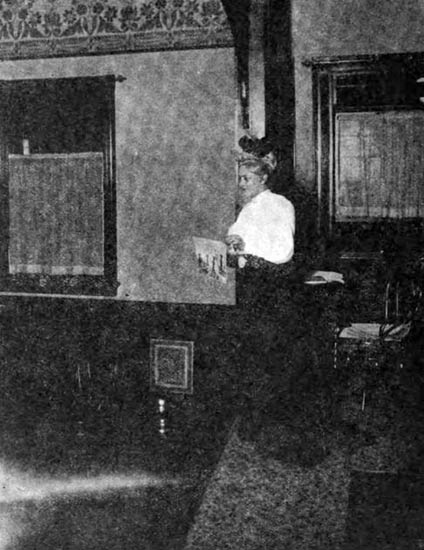
WTA president Ida C. Bender delivering remarks from the stage of the auditorium, 1905.
Image source: Primary Education magazine January 1906
In 1904, with a thriving organization of over 600 members, the assocation determined that major renovations were needed to the Chapter House. The Buffalo firm of Esenwein & Johnson was hired to make modifications to the building. Photos in these slideshows illustrate that the Chapter House was built with an auditorium/lecture hall on the first floor, a small kitchen at the right of the stage, a basement kitchen, a second floor reception/drawing room, one staircase leading to the second floor, a third floor caretaker's apartment, a third floor library and reading rooms.
The renovations designed by Esenwein & Johnson included adding dormers to the third floor to create more meeting space and light, updating the basement kitchen to permit food preparation for large groups, preparing the first floor auditorium for rental by installing doors to close off the second floor, adding a new stairway on the north end of the building to ease traffic going up to the reception/drawing room, widening the south stairway, and adding a smaller kitchen on the third floor. The reception/drawing was enhanced by the addition of a men's room (where there had been only a women's room), a small dining room, installation of a new bay window on the west side. On the third floor, the library would be improved by funds donated by Ada Kenyon in memory of her late sister, Carrie. Bookcases with leaded-glass doors were installed on either side of the room, and a wide window seat beneath the south windows overlooking Johnson Park. Miss Kenyon also furnished the room with Mission-style furniture. Including furnishings, the total renovation of the Chapter House cost $12,000 in 1904 and took from June to October to complete. Funds were raised by borrowing money from members at 5% interest.
The decor was consistent with the Art Nouveau period. The auditorium featured walls of a sunny yellow with a border of a red pattern. The wainscoting was also red. In the new second floor lobby at the top of the new north stairs, they installed a stained glass window donated to the WTA by Charlotte Mulligan. The second floor reception room and dining room were wallpapered with dark green paper especially printed for the room in a green foliage design with gold tinted leaves. The reception room ceiling had beams added to resemble an English hall.The floor was covered with a Brussels carpet with a soft tan background in a pattern harmonizing with the walls, velour curtains and hangings. The library and meeting rooms on the third floor were painted in a soft yellow. The library wainscoting was weathered oak. Beneath the window, the cushioned seat was a rich green.
As seen in the first image of the above slideshow, showing teachers gathered for one of the Saturday afternoon programs in the reception room, the WTA used the second floor areas for its teas, musicales, and other Association events.
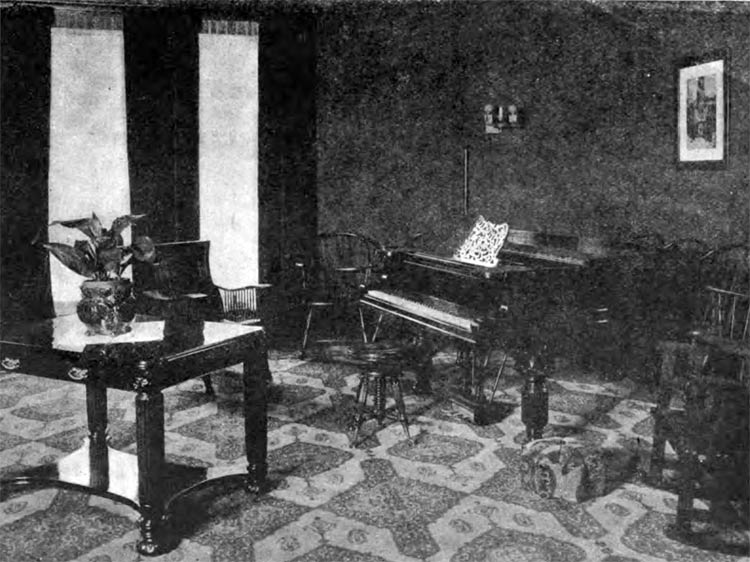
The Steinway piano in the southwest corner of the Reception Room, which was paid for through a subscription fund in 1902.
Image source: Primary Education magazine, January 1906
The WTA was Buffalo's first teacher's union, tackling head-on major issues such as the need to establish funds for teacher pensions, salary increases, professional staff development. The WTA created the Women Teachers Mutual Benefit Association to assist with member death or disability benefits. Membership increased steadily until reaching a peak in 1932 of 1,397 members. By that time, New York State had established the Teacher's Retirement Fund and salary negotiations were being managed by a Federation of Educational Associations (later known as the Buffalo Teachers Federation). Continuing education of teachers was being included in employment contracts. The WTA's function began to shift toward filling social and philanthropic needs for its members and the community. During WWI and WWII, the organization used its Saturdays to provide material goods for soldiers as well as relief in war-torn countries. In 1942, membership was 650; by 1948, it stood at 265. And in 1946, the WTA, now spending three-quarters of its annual budget in building maintenance and facing some major repairs, voted to sell the Chapter House. They sold it in 1947 to the Greater Buffalo Foreign Service Veterans for $11,471.92. The association disposed of the furniture and placed into storage more valuable or sentimental items. They met at the Town Club beginning in 1945. In 1968, when the Town Club sold its building, the WTA met at the Statler Hotel and various other locations. Although many regretted the loss of a clubhouse, changing demographics and dwindling membership made acquiring another building impossible.
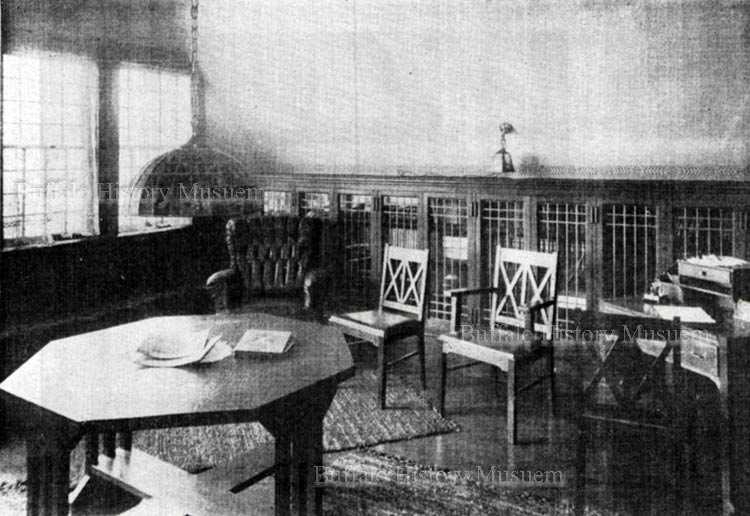
Third Floor Carrie Kenyon Library. Image source: Buffalo History Museum
The Chapter House was also in decline after 1947. In 1954, it was sold to the American Rescue Workers, which used its kitchen and auditorium to feed homeless men and women. At some point, the building became vacant and suffered the loss of architectural details such as the library's leaded-glass cases, seen above. In the 1990s, actor Richard Lambert purchased the Chapter House and lived on the third floor while working to renovate the lower floors for use as a theater. He opened the building as the New Phoenix Theatre in 1996 and serves as its Executive Director. In 2001, he sold the building to the New Phoenix Theatre which now owns it outright.
The WTA continues in 2013, although its membership stands at less than 100 members, mostly retired teachers who recall how the WTA filled a need for community that may no longer exist among Buffalo teachers. The organization awards two scholarships per year, for which the annual fashion show, one of its oldest fundraisers, contributes a major part.
Resources for this pictorial include "History of the Women Teachers Association, Buffalo," a 1951 thesis by Esther Schirmer, scrapbooks from the BECPL Grosvenor Room, WTA records housed at the Buffalo History Museum. Watermarked images above are from the Buffalo History Museum and may not be reused without express permission from that organization.
Special thanks to Richard Lambert, the creative force behind the New Phoenix Theatre for 27 years and who permitted me to freely roam the building and photograph; to Cynthia Van Ness of the Buffalo History Museum, who searched persistently for WTA records; and to Mary Lauria and Sandy Falletta, board members of the WTA, who treated me to an evening of discussion of the WTA's legacy as well as to dinner.



